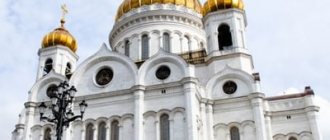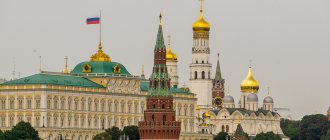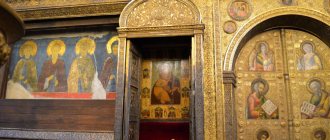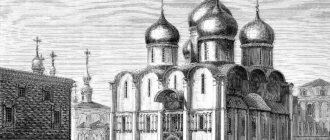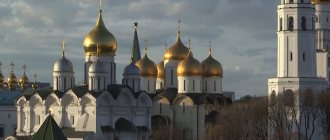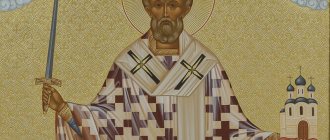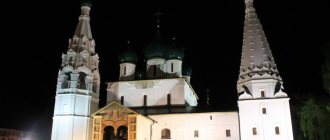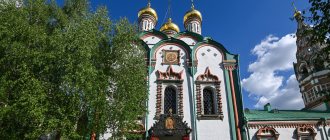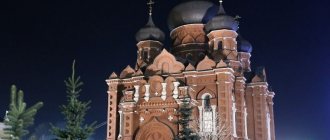In the very center of Moscow, on the Cathedral Square of the Moscow Kremlin, stands the white brick bell tower church of St. Ivan III the Great, which unites all the diversity of the ancient temples of the Kremlin into a common architectural ensemble. The ensemble includes the pillar of the Ivan the Great bell tower, the Assumption Belfry and the Filaret extension.
Currently, the Ivan the Great Bell Tower is a museum of the history of the Moscow Kremlin. On the ground floor of the Assumption Belfry there is an exhibition hall in which art monuments are demonstrated not only from the Kremlin, but also from a variety of museums from around the world. As exhibits, visitors are presented with a panorama of Moscow, a number of fragments of white stone architecture of the 14th century and many other rarities.
The Bell Tower of Ivan the Great is also called the Church of St. John Climacus. Entrance to it is with tickets to the territory of the Moscow Kremlin.
Ensemble of the bell tower "Ivan the Great". View from the Great Kremlin Square, © Valentin Overchenko
Year and century of creation
This temple is a very ancient architectural monument; its history goes back more than 500 years. Historians date the first information about the existence of a throne in the name of St. John Climacus in the sacral topography of the capital to 1329. The chronicles indicate that it was then that the stone church was founded and then consecrated. The shrine was classified as a type “like bells” due to the location of the belfry tier above the room itself.
The entire temple was erected within three months, which is why it is assumed that the church was small in size. It is believed that it became the first Moscow church consecrated in the name of the saint.
In 1346, the temple was painted, and 129 years later, several sarcophagi with the relics of saints were transferred to it from the second Assumption Cathedral, which at that time was dismantled. Later, the temple was also dismantled, and in the spring of 1505, construction of a new shrine began, which lasted three years. The construction of the new church was timed to coincide with the death of Prince Ivan III, and it was completely completed by 1508.
Ivan the Great Bell Tower in Moscow on Google panorama:
REVEREND JOHN THE LADGE CHURCH IN THE MOSCOW KREMLIN (IVAN THE GREAT)
According to the chronicle, “at the same time, St. John the Climacus, like the bells, demolished another church, created by the Grand Duke Ivan Danilovich in the summer of 6836, and founded a new church, St. John, not in the old place” (PSRL. T. 12. P. 258 -259). This news comes immediately after the message about the dismantling of the old and foundation of the new cathedral of the arch. Michael, which took place on May 21, 1505, from which we can conclude that the construction of the I.L. c. in the spring of that year. Its construction was completed 3 years later, in 1508, simultaneously with the Archangel Cathedral and the Church. Nativity of St. John the Baptist at the Borovitsky Gate (the exact date of the consecration of I.L. Church is unknown).
Church-bell tower of St. John Climacus. 1505–1508 Reconstruction. Drawing by E. M. Orlova Church-bell tower of St. John Climacus. 1505–1508 Reconstruction. Drawing by E. M. Orlova From the chronicle report on the completion of the construction of 3 temples in the Kremlin, the name of the builder of the bell tower is known. architect Bona Fryazina (“The same summer (7016) the church of St. Michael the Archangel on the square and St. John the Baptist, like the bells, and St. John the Baptist at the Borovitsky Gate, and the master of the churches Aleviz Novaya, and the bell tower Bon Fryazin" - PSRL. T. 13 . P. 10). There is no exact information about the origin of Bon Fryazin. V.N. Lazarev admitted that he, like Aleviz the New, was a native of Venice (Lazarev V.N. Byzantine and Old Russian Art. M., 1978. P. 291). S. S. Podyapolsky believed that Bon Fryazin could be one of the masters who came to Moscow with the embassy of Dmitry Ralev and Mitrofan Karacharov. The composition of this batch of masters is known thanks to the letter of Mengli-Girey Vel. book Vasily Ioannovich. Because of the Lithuanian-Russian war, the embassy tried to return to Rus' through Kafa (now Feodosiya), passing through the possessions of the Moscow ally. Prince - Khan Mengli-Girey. Khan detained the embassy and used one of the masters, Aleviz, to build a palace in Bakhchisarai (preserved portal of 1503). Podyapolsky believed that with this embassy came not only Aleviz, the only one named by Mengli-Girey by name, but also Bon Fryazin, Pyotr Frenchyushko (sent in 1508 to build the Kremlin in N. Novgorod), Bartholomew (built in 1508/09 Dorogobuzh with a master Mastrobon) and, more hypothetically, master Ivan (worked in Pskov in 1516/17) (Podyapolsky. 2006. pp. 267-268). Podyapolsky also assumed that the master named in the chronicles as Bon Fryazin and the master named in the discharge books as Mastroban or Mastoban are one person (Ibid. pp. 268, 301). If this is so, then Bon Fryazin, like others, was Italian. architects, e.g. Aleviz Fryazin was also a military engineer (see the mention of Dorogobuzh).
The temple of 1329 was located between the Assumption and Archangel Cathedrals and could not match the scale of the new cathedrals being rebuilt by the Italians. Bon Fryazin staged a new I. L. c. approximately along the same axis with the previous temple, but carried it much further to the east, beyond the line of the apses of the Assumption and Archangel Cathedrals. As a result, a square with trapezoidal outlines was formed, the main axis of which ran through the center of the main throne room of the Faceted Chamber and I.L. The construction of a new church-bell tower introduced the principle of regularity and centricity into the organization of the square (Bondarenko I. A. Reconstruction of the Cathedral Square of the Moscow Kremlin in the late 15th - early 16th centuries and the creative method of Italian masters // Architectural Heritage. M., 1995. Issue 38. pp. 210-211) and became a stage in the formation of the appearance of the Kremlin in Italy. masters.
Consecration of the church by St. John Climacus. Miniature from the Facial Chronicle. 70s XVI century (BAN. 31.7.30–1. L. 309)
Consecration of the church by St. John Climacus. Miniature from the Facial Chronicle. 70s XVI century (BAN. 31.7.30–1. L. 309)
Bon Fryazin created a unique structure, characterized by a large margin of safety of the load-bearing structures, which ensured the safety of the building. Even the explosion of mines laid in 1812 by the French did not affect their strength. troops under the cathedral belfries. Apparently, it was the nature of the soil and the tasks of constructing a high-rise structure unprecedented for Moscow at that time that determined the features of the foundation, laid on a continuous pile field (on piles of different lengths, driven almost close to each other), above it there was a stepped white stone stylobate. An octagon of the 1st tier, consisting of 2 floors, was erected on it from brick; a temple was located on the lower floor. The thickness of the walls reaches 5 m. They entered the church-bell tower from the west, through a small but high vestibule, covered with a cross vault (not preserved), which rested on white stone imposts (hewn, one has been restored to this day). From the vestibule there was an entrance to the temple, as well as to 2 internal staircases: a straight northern one and a spiral southern one. In plan, the church was one of the types of centric temples with exedra known in Renaissance architecture. However, traditional The octaconch underwent modification here. Due to the need to build a vestibule, and also due to the presence of 2 staircases running through the thickness of the walls of the octagon, the architect abandoned 3 exedra, making 3 sides zap. parts of the octagon are straight, abolished the window to the north. exedre. The temple is illuminated by only 4 windows. The design of the window openings is very unusual and is determined, on the one hand, by the enormous thickness of the walls, and on the other, by the height of the conchs above the exedra. The light opening cut into the wall of the exedra is significantly lower than the corresponding opening in the outer wall of the octagon. Because of this, a steep and long window sill slope was formed, and the arch of the window niche was significantly higher than the light opening cut into the wall of the exedra. The naos of the temple is covered with an 8-sided vault, at the base of which there is a white stone cornice, and at the top there is a white stone rosette.
Unlike the church of 1329, the new temple was not painted. There is no chronicle information about this, and fragments of possible paintings were not found during the restoration study of the walls in 1977.
The lower octagon was intended not only to house the temple, but also to equip the 1st tier of ringing with massive bells. With the size of the church limited by architectural expediency, and with the need to raise heavy bells to a considerable height, the task arose of reducing the mass of the masonry and its pressure on the church vaults. Therefore, Bon Fryazin created an intermediate floor between the temple and the bell ringing area. He built a centric 8-sided room located directly above the temple. 3 chambers communicate with it, designed to relieve the vaults of the vestibule and straight staircase from the weight of the masonry. All premises could also have economic purposes. You can enter the intermediate floor from the landing of a straight staircase, which was presumably intended for lifting chests with the treasury in the event of a fire in the Kremlin. Further along the same stairs you can get to the level of the 1st tier of the bell, where the 2nd, spiral staircase led directly from the 1st floor. To create the bell ringing area, the architect narrowed the walls of the 8-sided pillar almost in half (to 2.5 m). A covered gallery was built outside the pillar; the pylons were connected by arched lintels. Bells were hung between the pylons.
Ringing bells c. St. John Climacus. Fragment of a miniature from the Facial Chronicle. 70s XVI century (BAN. 31.7.30–1. L. 493)
Ringing bells c. St. John Climacus. Fragment of a miniature from the Facial Chronicle. 70s XVI century (BAN. 31.7.30–1. L. 493) The second tier of the pillar, which can conventionally be called the middle octagon, is significantly narrower than the lower one, due to which a free walkway was formed above the arches of the gallery of the 1st tier of the bell. Most of the middle octagon, the highest part of the pillar, is the pedestal for the 2nd tier of the bell, located in its upper part, at a height of more than 40 m from the ground. To lighten the weight of the structure and increase stability, the architect created an empty space inside almost the entire height of the figure of eight. It has no independent purpose and performs only a constructive function. The ascent from the 1st tier of the bell to the 2nd is carried out via an internal spiral staircase. For the installation of the 2nd tier of bells, the walls of the octagon were cut through with arches, in which bells hung. In the center of the platform of the 2nd tier of the bell, surrounded by arches connecting the pylons, a stone pillar was erected, inside it there is a stone spiral staircase to the upper tier of the bell, where the smallest bells are located. At the level of the upper tier of the bell, to reduce weight, the thickness of the walls was reduced to 80 cm, due to which a walkway was formed above the 2nd tier of the bell, as well as above the 1st, this time decorative. Thus, by gradually reducing the thickness of the walls and making them lighter due to hollow chambers, the architect created a structure that, despite its height, is particularly durable and stable.
What was the completion of the pillar of 1505-1508 remains unknown. The reconstruction, which involves completing the 3rd tier with a dome reminiscent of the completion of the cathedral of the Moscow VysokoPetrovsky Monastery, has recently been disputed. The involvement of another circle of analogues and the analysis of images of the pillar on miniatures from the Front Chronicle (70s of the 16th century) suggest that the completion of the temple should have been in the form of a brick tent, similar to the completion of the Italian. campanilla (Petrov. 2008). A study of bell towers in various regions of Italy shows that, despite the lack of direct analogies, I. L. c. 1505-1508 fits organically into their series. Thus, in Italy, the tradition of building high bell tower structures was widespread, raising the tiers of bells to a considerable height. Over a long period (XII-XV centuries), 8-sided pillar-shaped structures were built in various regions of Italy. Also in plural. Italian Campanillas use the technique of reducing the diameter of the upper parts of the pillar compared to the lower ones, mainly at the level of the upper tier of the bell. The resulting platform often serves as a bypass arched gallery on pillars or columns surrounding the upper octagon or cylinder (for example, the 8-sided bell tower at the Church of San Nicola in Pisa, ca. 1170 and (or) between 1230 and 1250).
Composition by I. L. c. has a number of features that distinguish it from similar Italian ones. buildings: firstly, this is a rare combination for Italy of the bell and temple functions in one building; secondly, it is a system of internal staircases and rooms inside the pillar; thirdly, this is the accentuated gradation of the entire composition - rare, but found in the construction of towers above the cross in cathedrals, for example. in Lombardy. Nevertheless, the analogies of I. L. c. are found in the drawings of the Quattrocento's architectural treatises. An example is a pillar-shaped structure with a chapel in one of the lower tiers and a bell in the upper one in Philaret’s “Treatise on Architecture” (1460-1464; Ibid. p. 81). The architectural plan outlined by Filarete coincides with the principle of combining the temple and bell functions, which existed in Russian. traditions. However, it was Bon Fryazin who created a type of structure that had not existed before either in Russian or Italian. architecture. All known centric, round, 8- or 9-sided bell structures in Rus' were built after the construction of the Moscow pillar. Bon Fryazin, having implemented his project, went beyond the boundaries of local tradition, finding fundamentally different forms of combining a church building with a bell structure.
Decor I. L. c. is intended to emphasize the logic of constructing the volume, primarily the tiered nature of the overall composition. This approach to the decoration of pillar-shaped structures also finds analogies in Italian. campanilla (see, for example, at the Church of San Gottardo in Corte in Milan, 1330-1336). The archway on brackets, placed under the cornice, which marks the base of the lower tier of the bell, is a typical element of Romanesque architecture. At the same time, the cornice combines Gothic elements (3-lobed arches) and classic elements (crackers, droplets and ovoid details). More simplified cornices emphasize other horizontal divisions of the pillar (3-lobed arches and croutons). The decorative motifs used by Bon Fryazin reveal parallels in the buildings of Vicenza, Montagnana, Bologna and Ferrara, as well as cities in the region. Abruzzo: Teramo, Atri, Campli, Corropoli, Chieti. Restoration studies 1968 and 1978 made it possible to determine that initially, like other Italian buildings. masters beginning XVI century, I. L. c. was painted to look like brick.
Architects of the Ivan the Great Bell Tower
In 1532, a belfry with the Church of the Ascension of the Lord was added to the northern side of the temple by the Italian architect Petrok the Small, and the “Blagovestnik” bell, weighing one thousand poods, was placed in it. The shrine itself occupied the third tier; to enter it, a staircase was built.
The construction of such campanile towers is an Italian tradition, which was introduced into the ensemble of the Moscow Kremlin by the architect Bon Fryazin , who had worked in Venice for a long time up to that point. Bon Fryazin preserved the idea of the first temple-bell tower made of wood and became the creator of a new stone bell tower with space for performing services. He was involved in the construction of the two lower octagonal tiers and part of the third. In the construction of the first tier, he laid metal beams.
The square, located to the east of the shrine, received the name Ivanovskaya. It was here that the tsar’s decrees were announced with all their might, “in all Ivanovskaya,” and the guilty were punished.
In 1600, an architect named Fyodor Kon organically complemented the composition and built on the bell tower without spoiling Bon Fryazin’s plan. Tsar Boris Godunov acted as the customer.
In the 17th century, the church was made into a belfry and was named Uspenskaya. During the years when Mikhail Romanov was on the throne, the architect Vazhen Ogurtsov added another structure to the north side - the Filaretov extension, which has white stone pyramids and a tiled tent.
The Patriotic War of 1812 led to the destruction of the belfry and the extension; only the bell tower remained intact. The cross, which is still listed as lost, was removed from it; now an iron eight-pointed cross is placed on the gilded dome of the bell tower; it is covered with gilded copper sheets. The top crossbar is complemented by the words “King of Glory” carved on it.
© Sergey Kuznetsov
In 1819, the destroyed belfry and the Filaretov extension were restored and returned to their former appearance, the work was based on the design of the architect Dominico Gilardi, and the architects Luigi Rusca and Ivan Egotov . The buildings were supplemented with elements of 19th century architecture.
For a long time, the bell tower remained the tallest and most significant building in the capital. It served as a lookout point and helped the suffering to unite in faith. However, due to revolutionary events, the usual course of history was shaken.
In 1918, the territory of the Moscow Kremlin was turned into a hostel, which became overnight accommodation for more than two thousand people. The outbreak of the Great Patriotic War led to the location of the command post of the Kremlin regiment on the territory of the Assumption Belfry. A communication center was placed in the nearby Tsar Bell.
After the war, the church began to turn into a museum.
© Olga Derzhavina
Construction of the bell tower
In 1532, it was decided to attach a large bell tower to the building of the Church of Ivan the Great. This task was entrusted to the Italian architect Petrok Maly Fryazin. The architect coped with the task by attaching a belfry to the temple along with the church, which was named in honor of the Resurrection of the Lord. In this church, a bell weighing a thousand poods (more than 1.5 kilotons), called the “Blagovestnik”, was installed. The temple was located on the 3rd tier of the entire architectural complex, and in order to get into it, a special staircase was built. At the beginning of the 17th century, on the initiative of Mikhail Romanov, the Church of the Resurrection of the Lord was transformed into the Assumption Belfry. And in the 30s of the same century, during the patriarchate of Father Philaret, the Church of Ivan the Great was supplemented by another structure - an extension with a roof of tiles and pyramids of white stone. The extension in honor of the patriarch was named Filaretovskaya.
The height of the bell tower of Ivan the Great
Immediately after the construction of the new church in 1508, the townspeople were amazed by the size of the new shrine - such high stone churches had not been built either in Moscow or throughout Rus'. At its highest point, the temple reached a height of 81 m.
The shrine immediately became an expression of the power and strength of the capital. A white-stone “pillar of glory” of enormous size, towering with its shining golden head above the Kremlin hill, informed everyone approaching the city about the greatness of Moscow.
Height of the Ivan the Great Bell Tower: 81 m.
View from the Ivan the Great Bell Tower
Currently, the bell tower offers an amazing view of the historical center of the capital. Several centuries ago, in the absence of dense buildings, from the top point of the bell tower one could see the territory 30 m ahead, which made it possible to use the shrine as a key sentinel point of the city. There is information that the path to the top, consisting of 429 steps, was once overcome by Alexander Pushkin and Mikhail Lermontov.
1 of 4
View of the Archangel Cathedral from the Bell Tower of Ivan the Great Photo: © Komova Anastasia
The bell tower is higher than the bell tower of Ivan the Great
For many years, the Ivanovo Bell Tower continued to be the tallest building in Moscow. All attempts to build something higher than it turned out to be failures.
Nevertheless, after some time, the closest associate of Emperor Peter I, Alexander Menshikov, built the Church of the Archangel Gabriel, which was 84.4 m high. The shrine exceeded the bell tower of Ivan the Great by three meters, which led to discontent among Muscovites.
When the church tower was struck by lightning, destroying the upper wooden part, the townspeople considered it God's punishment for an attempt on the authority of the Kremlin shrine. And in 1860, the bell tower handed over the palm in height to the Cathedral of Christ the Savior, which appeared in the capital, which now found itself first on the list of the tallest buildings in Moscow.
© Sergey Nar
Assumption Belfry
In 1532, near the Ivanovo Bell Tower, the Italian architect Petrok Maloy, builder of the walls of Kitai-gorod, began the construction of the Church of the Resurrection, later renamed the Church of the Nativity. Then this church was rebuilt into a belfry for large bells, now known as the Assumption - after the name of the main Assumption bell. On the ground floor of the Assumption Belfry, before the 1917 revolution, there were apartments for watchmen and bell ringers, and now there is an exhibition hall of the Kremlin museums with a changing exhibition.
On the third tier of the belfry there was once a throne of the Church of the Nativity of Christ. And in the 19th - early 20th centuries, the Church of St. Nikola Gostunsky. It was moved here in 1817, after the demolition of the ancient St. Nicholas Church, which stood on Ivanovskaya Square. Ivan Fedorov, the founder of book printing in Russia, served as the deacon of this church. A particle of the relics of St. was kept in the church. Nicholas the Wonderworker and the ancient icon of St. Nicholas, for which the temple itself was built under Grand Duke Vasily III. The icon was brought to the Kremlin in 1506 from the village of Gostuni near Kaluga, where it became famous for its numerous miracles. The location of these shrines is currently unknown.
The church preserved the ancient custom of coming with daughters “to St. Nicholas” before the wedding in order to arrange the marriage. This custom is based on the legend that Nicholas the Wonderworker helped one impoverished father marry off his three daughters, throwing each a bundle of gold out the window. The church was active until 1917.
The high stone staircase that leads from the outside to the entrance to the temple was first built under Ivan the Terrible in 1552. Later it was dismantled by the architect Matvey Kazakov at the request of Paul I for the construction of guardhouses here. In 1852, the staircase was restored “in ancient Russian taste” by Konstantin Ton, the author of the Cathedral of Christ the Savior. The staircase is currently closed.
Foundation
Bon Fryazin’s creation turned out to be very stable and durable. At that time, there were legends around the church that the architect buried the foundation so deep that it reached the level of the Moscow River. In fact, the Italian only covered the oak piles with stone, this allowed them to be saved from rotting.
The belfry was 25 m in diameter, the thickness of the walls of the first tier was very impressive - in some places it reached up to five meters.
Each octagonal tier of the bell tower has a smaller diameter and height than the one in front of it. They also have a subtle taper. Thanks to this structure, the structure is filled with visual lightness and extraordinary stability.
There was an opinion that the foundation of the shrine was very deep, but then it became known that the entire colossus was supported by oak piles only 4.5 m in length. The second and third bell tiers have high windows and are decorated with graceful “Lombard” arches. The addition of the upper round tier took place under Boris Godunov; it serves as a drum for the gilded dome. On the ground floor there was a tiny church of St. John the Climacus.
© Don-vip
Bells ringing
Ringing is a mandatory accompaniment of Orthodox worship, and Ivan the Great was and continues to be the main belfry in Moscow. It was from here that the first strike of the large bell sounded, which announced the beginning of ringing throughout the city during the Orthodox holidays. The bells fell silent in 1918, and were heard only once in 1921. In 1992, after a break of 74 years, the bells on the Ivan the Great Bell Tower rang again.
The exact number of bells that crown the Filaret annex, the belfry and the bell tower of Ivan the Great is 21. In ancient times, bells were hung on wooden beams; only in the 19th century did the beams become metal.
The belfry and the Filaretovskaya extension have only three bells. The most voluminous is Uspensky, its other name is Festive, it weighs over 65 tons. This bell was cast by famous foundry masters Rusinov and Zavyalov in the 19th century. The Assumption Bell is absolutely deservedly considered the largest of all existing bells and the best in terms of sound characteristics - its purity of tone and power of sound are amazing.
Third tier of the bell tower, © Valentin Overchenko
The Revun or Reut bell is also large in size, however, it is twice as large as the Uspensky bell, its weight is more than 32 tons. The bell has a long history; its creation dates back to 1622; master Andrei Chekhov worked on it.
In the 18th century, the Russian foundry worker I. Motorin cast another bell for the bell tower of Ivan the Great, it was called the Everyday or Seven Hundred. It is also part of the Filaretov extension and weighs more than 13 tons.
The other 18 bells occupy the middle and lower tiers of the bell tower. The lower tier is equipped with six bells: Lebed, Bear, Shirokiy, Novgorodsky, Rostovsky and Slobodsky. The middle tier has 9 bells. Two of them have the same names - Korsun, they are distinguished by their whitish color. The remaining seven are named Novy, Maryinsky, Nemchin, Korsunsky (one more), Bezymyanny, Danilovsky and Glukhoy.
On the upper tier of the bell tower there are three bells without names.
Ringing bells: video
The fate of the Church of Ivan the Great during the war with Napoleon
Russia suffered a lot during the aggressive Napoleonic aggression of 1812. And it was during this difficult time that the Assumption Belfry and the Filaretov extension were destroyed. One of the few buildings that survived at that time was the bell tower with the “Blagovestnik”.
View of the bell tower from the Assumption Cathedral
It is known for sure that the French stole the domed cross from it, which has not yet been found. Currently, there is another cross on the bell tower - an iron one, eight-pointed in shape, with an ornamental coating in the form of gilded copper sheets. The inscription “King of Glory” is carved on the top crossbar of the cross.
.
Painting by A. V. Lentulov “Ringing. Ivan the Great belltower"
Painted in 1915, the painting depicts the shrine in sloping forms, with a bell in the center, swinging by two people. Wave-like planes diverge in circles around the entire building; they transmit the sensation of sound-hum, and thanks to the repeated individual forms of the composition in the form of stretched strings, the feeling of an organ or a huge harp is created.
The artist depicts the ringing bells as an event on a cosmic scale. One gets the feeling that the luminaries are spinning around the monument, either dipping it into the night, or directing rays of light at it. The whole picture became a kind of portrait of an architectural monument against the backdrop of history, filling it with waves of indestructible energy of life that resists destruction.

